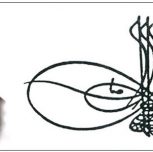(1785, 1808-1839)
Turkish Rondo (or Turkish March), one of the most recognized classical music pieces, was created in 1780 by Wolfgang Amadeus Mozart (1756-1791). The famous composer was inspired by the sound of the Turkish Janissary Bands, which were well known then. (1) When Mozart composed the “Turkish March”, the Sultan of the Ottoman Empire was Abdülhamid I (1725, 1774-1789).
Almost five years after the Turkish March was composed, Sultan had a son, named Mahmud, from 17- year-old Nakşidil Valide Sultan (1768-1817), one of the youngest concubines in the Sultan’s Harem.
Mahmud was 4 years old, when he lost his father, but he was not alone, as his mother was always with him during his childhood. In his teenage years, the succeeding Sultan Selim III (1761, 1789-1807), who was Mahmud’s cousin, was quite generous to Mahmud. He personally sponsored his education, and taught him how to administer the government.
Mahmud did not expect to be Sultan after Selim III died, as he was second in rank after his older brother, Mustafa IV (1779, 1807-1808). Sultan Mustafa IV was unexpectedly killed by the rebels in the second year of his reign. This unfortunate event opened the way of enthronement to Mahmud on 28 July 1808 with the imperial name “Mahmud II”. 23-year-old Mahmud II was mature, educated and experienced enough to be the 30th Ottoman sultan. Handsome looking Mahmud was smart, courageous, but a cautious person with a decisive and targeted personality. Mahmud’s thoughtful personality was reflected in his poems under the pseudonym of “Adli”.
During the first 15 years of his reign, Sultan Mahmud II did not have a male heir to the throne. This lack of a legitimate replacement created great concern among the Ottoman elites. The birth of Abdülmecid in 1823 was a most welcomed surprise to both 34-year-old Mahmud II and Valide Sultan Bezm-î Alem (1807-1853), his wife.
His Reforms
Unlike the other European countries, the Ottoman Empire did not have any national anthem, instead, there were imperial marches composed for each sultan by the imperial musicians. This tradition started with Mahmud II, who invited Ottoman-Italian Giuseppe Donizetti (1788-1856) in 1828 to be the general instructor of the newly established Imperial Orchestra (Mızıka-yı Hümâyûn). Donizetti composed the “Mahmûdiye Marşı” for Mahmud II in 1828. (2)
Mahmud II is considered one of the most important reformist sultans in the Ottoman Empire. One indicator of his reformist ways was his outfit in his paintings. He was the first Sultan portrayed in the official portraits as a modern man. Instead of dressing in traditional ottoman garb, he dressed in European style, wearing a ”Fez” hat, western tunics, trousers, and had a shorter beard than any of his predecessors. Untraditionally, he travelled within the country to learn the land, inspect the administrators and speak to the people. He was the first sultan who travelled around his empire without specifc war or religious reasons.
The most significant reform he achieved was the demolition of the old janissary (military) organization, and the establishment of the modern army on 16 June 1826, historically named Vaka-i Hayriye (Fortunate Event- Hayırlı Olay). This event was the beginning of his ongoing reforms.
The other major reform was to separate the military men and clergymen (ulema) from the government positions. Mahmud II wanted to create a professional career system. He initiated an unusual public relations campaign to establish his authority in the public. He put his picture in government offices in special state ceremonies. Nobody had ever seen this type of camapaign before.
Mahmud II was impressed by the modernization movements in western countries. He closely followed recent developments and tried to bring them into the Empire. Mahmud believed that in order to modernize the army, reforms should be spread to the non-military institutions, like education, music, government workers, etc.
He opened the first Medical School (Tıbhane-i Amire) and Surgery School (Cerrahhane-i Amire) in 1827; the first Ottoman newspaper (Takvim-i Vekayi) in 1831; the first Military Academy (Mekteb-i Harbiye) in 1834; the first modern school (instead of Enderun) to educate potential state officers (Mekteb-i Maârif-i Adliye) in 1837. He opened the first non-military educational institution and initiated the secondary school system. Sultan Mahmud II rebuilt the burned Selimiye Barracks out of stone in 1828. It is now one of the largest structures in Istanbul.
Among the reforms was the modernization of the Turkish Janissary Band. Mahmud II demolished it and established a new band, called the Imperial Band (Mızıka-yı Hümâyûn) in 1831. The old Janissary Band inspired Mozart around 1780, but the new Imperial Band impressed the Hungarian composer and virtuoso pianist Franz Liszt in 1847 to compose “Paraphrase for Sultan Abdülmecid”.
The Letter of Tanzimât (Constitutional Monarchy)
The other important change was the reorganization of the Ottoman Empire, called the Tanzimât, which aimed to modernize the empire and the military, to integrate minorities into the society, to improve equality, and to provide efficiency in bureaucracy. The reorganization was necessary, as the empire was behind the European states in terms of technology, military and social rights. Europe was giving birth to democracy initiated by the French Revolution in 1789. The sultans in the Ottoman Empire, especially Mahmud II, held the ultimate power, and shared his power with nobody. In addition, there were no institutions to judge the sultan’s authoritative decisions either. This became a major concern among the Ottoman bureaucrats. The Letter of Tanzimât, prepared by the bureaucrats led by Mustafa Reşit Pasha (1800-1856), the Foreign Minister, was presented to the public in Gülhane Park of the Topkapi Palace on 3 November 1839.
Mahmud did not see the presentation of the letter, as it was four months after his death. Mahmud II, therefore, became the last Ottoman sultan who had ultimate power without any limitation. The following sultans abided by the conditions dictated on the Letter of Tanzimât. 69 years later, “constitutional monarchy” was introduced to the Empire on 24 July1908 during the reign of Sultan Abdülhamid II.
Final Years
Sultan Mahmud II died on 1 July 1839 from tuberculosis at the age of 54. His throne was given to his 17-year-old son, Abdülmecid, the next day. Succeeding sultan, Abdülmecid, had to sign the letter, and abided by the terms throughout his reign.
The period from 1839 until when the first parliament was established in 1876 is called the “Tanzimât Era”, which covers the entire period of the reigns of Sultans Abdülmecid and Abdülaziz.
In order to honor his father, Sultan Abdülmecid built in 1840 a completely new mausoleum (türbe) complex, the Mausoleum of Mahmud II. In later years, his brother Sultan Abdülaziz and his son Sultan Abdülhamid II were also buried in the mausoleum in 1876 and 1918, respectively. The octagonal mausoleum marble exterior is located in the Çemberlitaş neighborhood of Eminönü District in Istanbul. The interior design and decoration of the mausoleum resembles a palace.
Mahmud II is remembered as one of the most reformist sultans in Ottoman history.
(2) When Abdülmecid became the new sultan, Donizetti composed the “Mecidiye Marşı”. Likewise, Ottoman-Italian Callisto Guatelli (1820-1899) composed the “Aziziye Marşı” for Abdülaziz in 1861. Ahmed Necib Paşa (1812-1883) composed the“Hamidiye Marşı” for Sultan Abdülhamid II. These marches were used as anthems during the reigns of those sultans (X1). The National anthem in modern Turkey was adopted in 1921. It was written by Mehmet Akif and composed by Zeki Üngör.
Ali Şükrü Çoruk, (2011), “II. Mahmud ve bir iktidar sembolü olarak resim”, MOSTAR, Ock, 2011, Sayi: 71.
Fatih Demirel, (2012), Tarih İncelemeleri Dergisi, Cilt/Volume XXVII, Sayı/Number 2 Aralık/December 2012, 339-358
Harun Korkmaz, (2011), “Sultan Abdülmecid döneminde Osmanlı müzik hayatı”, MOSTAR, Ekim, 2011, Sayi: 80.
Mehmet Ali Yildirim, (2010), “TANZIMAT DÖNEMINDE MESLEK OKULLARI”, Ankara University.










